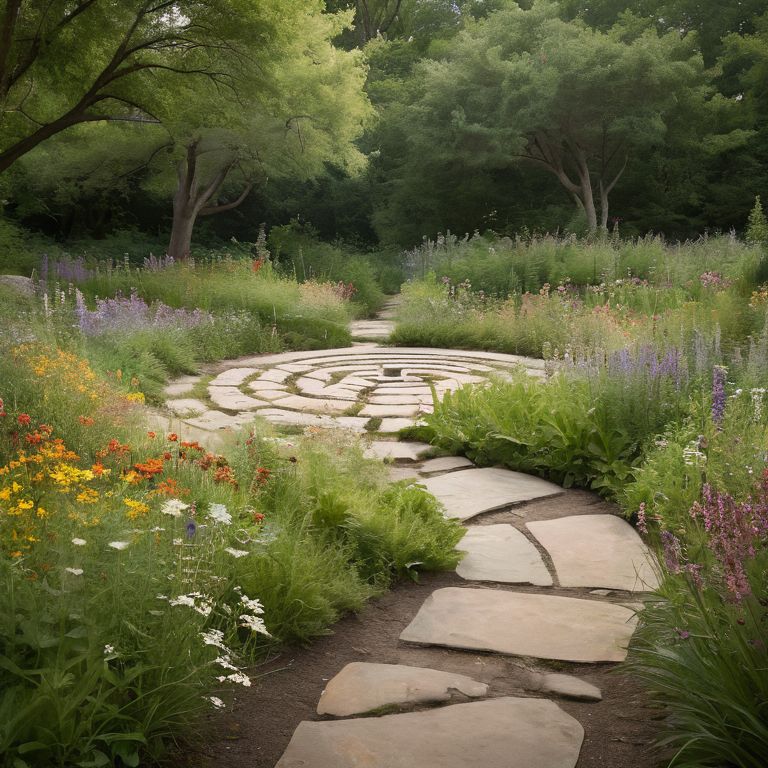Take a deep breath in, and as you exhale, allow your eyes to gently focus on the present moment. I still remember my first experience with using a labyrinth for walking meditation – the way the winding paths seemed to quiet my mind and guide my feet towards a sense of inner peace. It’s a common misconception that labyrinths are only for spiritual or mystical pursuits, but I’ve found that they can be a powerful tool for anyone looking to cultivate mindfulness and reduce stress.
As we explore the practice of using a labyrinth for walking meditation together, I want to assure you that this isn’t about achieving some sort of mystical state or emptying your mind completely. It’s about embracing the simplicity of the present moment, one step at a time. In this article, I’ll share practical, no-nonsense advice on how to get started with labyrinth walking, from finding or creating a labyrinth to incorporating it into your daily mindfulness practice. My goal is to help you discover the peaceful benefits of this ancient practice, and to make it a accessible and enjoyable part of your self-care routine.
Table of Contents
Guide Overview: What You'll Need

Total Time: 30 minutes to 1 hour
Estimated Cost: $0 – $100
Difficulty Level: Easy
Tools Required
- None just comfortable walking shoes
Supplies & Materials
- Access to a labyrinth can be indoor or outdoor, large or small, traditional or modern design
- Water for hydration before, during, or after walking
- Journal or notebook optional for reflection after meditation
Step-by-Step Instructions
- 1. To begin our walking meditation in the labyrinth, take a deep breath in, feeling the air fill your lungs, and then exhale slowly, allowing any tension to release. As you stand at the entrance of the labyrinth, take a moment to notice the sensation of your feet touching the ground, the sounds around you, and the sensation of the air on your skin.
- 2. Next, set an intention for your walk, which could be as simple as letting go of stress or cultivating a sense of calm. Allow this intention to be your guiding principle as you navigate the labyrinth, reminding yourself of it whenever your mind wanders. Take another breath, and when you’re ready, step into the labyrinth.
- 3. As you start walking, pay attention to your breath, using it as an anchor to keep you present. Try to let go of any thoughts about the destination or the path ahead, focusing instead on the sensation of each step. Notice how your feet touch the ground, the movement of your legs, and the rhythm of your breathing.
- 4. The path of the labyrinth will begin to wind and turn, and it’s essential to let go of any need to control or understand where you are in the pattern. Simply focus on the present moment, taking one step at a time. If your mind starts to wander (and it probably will), gently acknowledge the thought and return your attention to your breath and the sensation of walking.
- 5. As you walk, notice the sensory experiences around you – the sights, sounds, and smells. Take in the beauty of nature, the textures of the path beneath your feet, and the sensations in your body. Allow these experiences to enrich your walk, deepening your connection to the present moment.
- 6. When you reach the center of the labyrinth, pause and take a moment to reflect. Notice how you’re feeling, what thoughts are present, and any sensations in your body. Take a few deep breaths, and allow yourself to settle into the stillness of this space. Remember, the goal isn’t to achieve a specific state but to simply be present.
- 7. As you begin your journey back out of the labyrinth, carry the sense of calm and presence with you. Notice how your walking has slowed, your breathing has deepened, and your mind has quieted. Take this sense of peace with you, back into your daily life, and remember that it’s always available to you, just a breath away.
Walking the Inner Path

As we embark on this journey of labyrinth walking techniques, remember that the goal is not to reach the center, but to be present with each step. Mindfulness is key, allowing us to let go of distractions and focus on the sensation of our feet touching the ground. With each breath, feel the weight of your body distributed evenly, and the gentle movement of your legs as you walk.
Incorporating meditation for stress relief into your labyrinth walking practice can be as simple as paying attention to your breath. Notice how your body responds to the peaceful surroundings, and allow yourself to let go of any tension. As you walk, imagine that with each step, you are releasing worries and concerns, creating space for clarity and calmness to emerge.
To deepen your practice, consider creating a personal labyrinth in your own backyard or a nearby park. This can be a powerful way to make the experience more intimate and accessible. As you walk your personal labyrinth, remember to focus on the benefits of mindfulness walking, such as increased awareness and a sense of inner peace. Allow yourself to settle into the present moment, and let the gentle paths guide you home to yourself.
Labyrinth Walking Techniques for Clarity
As we wander the labyrinth’s paths, let’s focus on techniques to clarify our inner world. Take a deep breath in, and as you exhale, allow your gaze to softly focus on the path ahead. Notice the sensation of your feet touching the ground, the rhythm of your breath, and the gentle sway of your body as you walk.
To deepen clarity, try pausing at each turn, breathing in the stillness, and exhaling any thoughts or tensions. Allow your inner wisdom to emerge, like a lotus blooming in the quiet depths of a pond. With each step, may you find greater clarity and peace.
Meditation for Stress Relief Through Mindful Steps
As we walk the labyrinth, let’s focus on the sensation of our feet touching the ground. With each step, allow any tension or stress to melt away, like leaves drifting gently to the earth. Remember to breathe, deeply and slowly, feeling the air fill your lungs and then release.
In this peaceful state, notice how your mind begins to quiet, like the stillness at the center of the labyrinth. Allow yourself to settle into this calm, letting go of worries and doubts with each mindful step.
Finding Your Way: 5 Gentle Tips for Labyrinth Walking Meditation
- Begin by standing at the entrance of the labyrinth, taking a deep breath in, and as you exhale, allow your eyes to gently focus on the path ahead
- Let your feet move slowly, one step at a time, feeling the weight and sensation of each foot touching the ground, as if anchoring yourself to the present moment
- As you walk, bring your attention to the sensation of the air moving in and out of your body, using your breath as a reminder to stay grounded and aware
- Allow your hands to relax by your sides, or gently clasped together, letting go of any tension or thoughts, and simply be present with each step
- When your mind wanders, gently acknowledge the thought, and then kindly bring your attention back to the sensation of your feet on the path, the rhythm of your breath, or the surroundings, without judgment or attachment
Embracing the Serenity of Labyrinth Walking: 3 Key Takeaways
Allow yourself to breathe in the tranquility of the labyrinth, and as you exhale, let go of the need for a specific outcome, simply being present with each step
Remember that the path of the labyrinth is a metaphor for life’s journey, with twists and turns that invite you to cultivate patience, trust, and self-awareness with every mindful step
As you conclude your walk, take a moment to notice the sensations in your body, the rhythm of your breath, and the sense of calm that has settled within, carrying this peace with you back into your daily life, one gentle step at a time
Embracing the Journey
As we walk the labyrinth’s gentle paths, may we remember that each step is a chance to weave together the threads of our thoughts, calm the turbulence of our minds, and find the stillness that resides at the heart of our being.
Elara Keane
Embracing the Journey Within

As we conclude our journey through the labyrinth, let’s take a moment to reflect on the key points we’ve explored. We’ve walked the winding paths, practiced mindful steps, and discovered the beauty of meditation for stress relief. We’ve also delved into labyrinth walking techniques for clarity, learning to quiet the mind and listen to the heart. By embracing this practice, we can cultivate a deeper sense of self-awareness, allowing us to navigate life’s challenges with greater ease and gentle presence.
As you close this chapter and embark on your own path, remember that the true magic lies not in the destination, but in the journey itself. May you carry the stillness of the labyrinth with you, and may it guide you back to the quiet space within whenever you need it. As you take your next step, recall the gentle wisdom of the labyrinth: that every path, no matter how winding, leads us home to ourselves, and that the greatest treasure lies in the present moment, waiting to be discovered with each breath.
Frequently Asked Questions
How do I find or create a labyrinth in my area to practice walking meditation?
Take a deep breath in, and as you exhale, imagine yourself standing in a peaceful labyrinth. To find one near you, try searching online for “labyrinths in [your city]” or check with local parks, gardens, or spiritual centers. If none exist, consider creating a temporary labyrinth in a quiet space using stones, chalk, or even just your feet, tracing a winding path to inner calm.
What if my mind wanders or I feel distracted during the labyrinth walk – how can I gently bring my focus back?
As your mind wanders, gently acknowledge the thought, and then softly bring your attention back to the sensation of your feet touching the ground with each step. Remember, it’s not about achieving a perfectly quiet mind, but about kindly returning to the present moment, again and again, with patience and compassion.
Can labyrinth walking meditation be adapted or modified for individuals with mobility issues or disabilities?
Take a deep breath in, and out. For those with mobility issues, labyrinth walking can be adapted to a seated or standing meditation, using visualization or finger tracing along a labyrinth design, allowing the mind to still wander the path, even if the body cannot.
